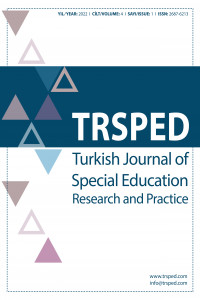Review
Research Article
Aim & Scope
Turkish Journal of Special Education Research and Practice (TRSPED) is an international peer-reviewed open access journal published annually in December. TRSPED addresses issues concerning with the development, education and rehabilitation of infants, toddlers, children, youths, and adults with exceptionalities.
TRSPED publishes empirical research, systematic reviews, meta-analysis,
position papers, literature reviews, theoretical papers, research-to-practice
papers, policy analysis and book/software review on special
education. The aim of the journal is to present
up-to-date-information about special education to scholars, clinicians,
educators, families, caregivers, administrators, and policy makers.
*TRSPED published 1 issue each in 2019, 2020, and 2021 and plans to increase the number of issues published to two in 2023.
TRSPED publishes original manuscripts focusing on the following topics*:
Definition, identification, and characteristics
Assessment and placement
Prevention and early childhood intervention
Effective curriculum and instruction
Scientifically-based and evidence-based practices
Behavior and classroom management
Family training and family involvement
Personnel preparation and teacher education
Professional standards and professional development
Transition and career development
Inclusion and inclusive practices
Related services and service delivery systems/practices
Legislation and special education laws
Ethical issues
Policy and policy implications
Assistive and augmentative technology and instructional technology
Cross-cultural comparison of special education
* Original manuscripts focused on other related topics not listed above will be considered for publication in TRSPED contingent upon the editorial review and decision.
Author Guidelines
Authors Guidelines and Writing Rules
Turkish Journal of Special Education Research and Practice (TRSPED) is an international peer-reviewed journal published annually in December. TRSPED addresses issues concerning with the development, education and rehabilitation of infants, toddlers, children, youths, and adults with exceptionalities (e.g. autism, culturally and linguistically diverse, emotional and behavioral disorders, hearing impairments, hyperactivity and attention deficiency, intellectual disabilities, language and speech disorders, learning disabilities/difficulties, multiple and severe disabilities, physical disabilities, and visual impairment), and giftedness and talent (i.e., gifted and talented individuals). TRSPED accepts manuscripts written in Turkish and English.
Type of Manuscripts:
TRSPED publishes empirical research, systematic reviews, meta-analysis, position papers, literature reviews, research-to-practice papers, policy analysis and book/software review focused on special education. The aim of the journal is to present up-to-date-information about special education to scholars, clinicians, educators, families, caregivers, administrators, and policy makers.
1. Empirical research studies published in TRSPED are those that include students with disabilities or who are at risk, their teachers, caregivers, siblings, or other service providers. Studies using group experimental, single-subject experimental, descriptive, correlational, observational, casual-comparative, survey designs as well as case studies, action research, and qualitative designs are welcome. Empirical research studies must have clear and important implications for special education research and practice. Primary criteria to evaluate empirical research studies include importance of the topic for the field of special education, design quality, quality of implementation and description, and discussion of the findings with respect to future research and implication for practice or policy. Manuscript length should be maximum 30 typewritten, double-spaced pages, including tables, figures, and references.
2. Systematic reviews and meta-analyses are focused syntheses that are important to improve and have clear implication for special education practices. Systematic reviews and meta-analyses should be up-to-date, comprehensive, and critical. Systematic reviews and meta-analyses should describe the procedure used to select the reviewed literature, evaluate the methodological adequacy and quality of the reviewed literature, discuss the major findings, and present implications for theory, research, policy or practice. Primary criteria to evaluate systematic reviews and meta-analyses include comprehensiveness of the review, methodological quality and adequacy, writing quality, depth and breadth, and value to the field of special education. Meta-analyses must report effect size estimates. Manuscript length should be maximum 50 typewritten, double-spaced pages, including tables, figures, and references.
3. Position papers are the papers that identify and examine the important theoretical and practical issues in special education. Position papers define, explain, compare, analyze, and conclude the specific positions such as an approach, model, system, and/or program based on the existing literature. Position papers should take into consideration both the impacts and limitations of the position. Manuscript length should be maximum 15 typewritten, double-spaced pages, including tables, figures, and references.
4. Research to practice papers are those that translate empirical research findings into actionable guidance for caregivers, special education teachers, or other service providers. Research to practice papers should be grounded in appropriate research base and an explicit connection to evidence-based practices in special education should be made. These manuscripts may include case scenarios and examples to illustrate how the practice described can be implemented across different settings with one or more individuals with special educational needs. Manuscript length should be maximum 20 typewritten, double-spaced pages, including tables, figures, and references.
5. Policy analyses are papers that provide research results and critical discussions related to legislations and policies on special education. Policy analyses should include the issues that impact the special education practices and the individuals with special needs. Manuscript length should be maximum 15 typewritten, double-spaced pages, including tables, figures, and references.
6. Book or software reviews are papers that introduce and evaluate books or software related to the field of special education. Book or software reviews should describe the purpose, content, functioning, and usage of the introduced book or software. Reviews must address and examine the book or software with a critical approach. Manuscript length should be maximum 5 typewritten, double-spaced pages, including tables, figures, and references.
Manuscript Preparation and Writing Rules:
The Publication Manual of the American Psychological Association - 7th edition (APA; 2020) should be followed when preparing all manuscripts. Authors should follow the general guidelines listed below:
1. A separate title page must be prepared for all manuscripts and include the following elements: (a) title of the manuscript (12 words or less), (b) type of the manuscript (as described above) (c) first, middle, and last name of each author with the higher academic degree obtained noted, (d) names of the intuitions in which each author is affiliated along with full addresses and e-mails for all authors, and (e) any acknowledgments, financial disclosure information, author notes, or other text that could identify the authors to reviewers.
2. All manuscripts should accompany a structured abstract of 130-150 words (depending on the manuscript type) and 3-5 keywords. The abstract should be placed on a new page after the Title page.
3. Title of the manuscript should include 12 words or less. The title should also appear on the first page of the manuscript (the next page following the Abstract page) above the first paragraph, centered and bold. All title and headings must be bold.
4. Length of manuscripts should not exceed the page-limit specified for each manuscript type above. Page limits include tables, figures, and references
5. All manuscript pages should be numbered in sequence, starting with the Abstract page.
6. When typing the manuscripts, an 8½ × 11 in. paper with 1-in. margins, double spacing, left alignment of the text, and Times New Roman 12-pt. type should be used. This formatting should be used in the Title page, Abstract, Tables, and Figures.
7. Tables and Figures should be formatted by APA style and placed at the ends of the paper following the References. Approximate places of the tables and figures should be noted within the manuscript using <TABLE X ABOUT HERE> notation. Each table or figure should be placed on a new page. Tables should be double-spaced and be created using Word’s table functions. All tables and figures must be cited in text.
8. Figures should be black and white only. In rare cases, color figures will be accepted when the black and white version of the figure is not readable. Pictures may be accepted on Research to practice papers.
9. Authors must obtain written permission for figures, tables, photos, other artwork, and extensive quotes taken directly from other sources.
10.Tab key and centering functions should be used for head alignment and paragraph indents, instead of the space bar.
11.Manuscripts reporting studies that involve human subjects must specify that ethical approval was obtained from an Institutional Review Board. Obtaining permission from an educational agency or other public entities is not sufficient alone.
12.All manuscripts written in Turkish (except Book or Software reviews) should accompany an extended English summary of 1000-1200 words. English summary should be placed following the Reference list of the Turkish manuscript. English summary for manuscripts reporting empirical research studies, systematic reviews, meta analyses, or literature reviews should include the following sections (as appropriate): Introduction (150-200 words including research questions), Method (300-350 words), Results (300-350 words), and Discussion (250-300 words with implications for future research and practice). English summaries for the position papers, research to practice papers, and policy analysis papers should include a separate summary of all major sections of the Turkish manuscripts. Book or software reviews written in Turkish should include an English summary of 250 words.
13.Biased language should be avoided in any part of the manuscript and authors must employ “people first language” when referring to or describing individuals with disabilities (e.g., students with disabilities, child with autism).
14.Authors should use an active voice and passive voice should be avoided (e.g., “Three teachers implemented the intervention” versus “Intervention was implemented by three teachers”).
15.Each section of the manuscript should only include information suitable for a given section. For example, authors should not interpret their findings in the Results section, should not present new data in the Discussion section, or should not repeat the same information presented in Results when discussing the findings in the Discussion section.
16.Effect size estimates should be provided in studies using quantitative research designs including those employed single-subject experimental research designs.
17.Within text citations and the Reference list should be formatted using the APA guidelines (2010). Digital object identifiers (DOIs) must be included in the reference list. All references cited within the manuscript should be listed in the Reference list and vice versa. Authors should cite relevant studies/work from Turkish and/or English literature as appropriate and studies cited within the manuscript should reflect the most current work (published within the last 10 years).
18.The Cover Letter must state that the purpose of the manuscript and its expected contribution to the field of special education and that the manuscripts has not been previously published, is not under review elsewhere, and will not be submitted for review elsewhere while it is being reviewed in TRSPED. Authors must also specify that approval from the appropriate Institutional Review Boards is obtained. The Cover Letter should be dated and singed by the corresponding author and include contact information for the corresponding author (full name, institution, address, phone number, e-mail address).
Manuscript Submission:
All manuscripts should be submitted electronically: http://dergipark.gov.tr/trsped. To submit a manuscript, Log in to the DergiPark system at http://dergipark.gov.tr/trsped by clicking the blue “Login” or green “Submit a Manuscript” buttons and follow the instruction once you logged in. If you are a new user, please register to the DergiPark system at http://dergipark.gov.tr/register/ (if you are a first-time user). Once you register, and log in to the system as described above. Please have all necessary sections (Title page, abstract, keywords, and main manuscript file with no identifying information, copyright agreement, and cover letter) before starting to the submission process.
Manuscript Review Process:
Acknowledgement e-mail will be sent to the author(s) within two days of the submission. A Co-editor will be assigned to each manuscript to conduct preliminary examination of the manuscript for content and format (aim and scope, importance, originality, characteristics of subjects, research design, length, written language, and APA style etc.). Manuscripts that do not meet the journal guidelines for content or format will be returned to the author within a week of original submission. Manuscripts passing the preliminary screening will be forwarded to an Associate Editor who will oversee the review process. Associate Editors will assign each manuscript to three reviewers who are experts in special education. The “double-blind” review process will take 6 to 8 weeks. Upon receiving all reviews, Associate Editors will make recommendation about the manuscript to the Co-Editors. After reading and evaluating the manuscript and the reviews, the Co-editors will e-mail the corresponding author a written editorial decision and the reviews. The decision will be one of the following: (a) Accept, (b) Accept with Revisions, (c) Reject, Revise, Resubmit, and (d) Reject. TRSPED aims to inform authors about the editorial decision within 12 weeks of their submission.
Copyright:
When submitting their manuscript to TRSPED, authors will be required to sign a Transfer of Copyright form.
Ethical Principles and Publication Policy
Turkish Journal of Special Education Research and Practice (TRSPED) has a Conflict of Interest policy in place and complies with international, national and/or institutional standards on research involving Human Participants and/or Animals and Informed Consent. The journal adopts/follows the Committee on Publication Ethics' (COPE) principles on dealing with acts of misconduct. The journal may use plagiarism detection software to screen the submissions. If plagiarism is identified, the COPE guidelines on plagiarism will be followed. Content published in this journal is peer-reviewed (Double Blind).
Price Policy
Article submission and processing are free of charge in the Turkish Journal of Special Education Research and Practice.
Indexes
Journal Boards
Editors

My current research interests include examining the impact of various professional development practices on preschool teachers’ implementation of evidence-based naturalistic instruction approaches; conducting applied research studies focused on improving development, engagement, and learning of young children with or at-risk for developmental disabilities, their families and teachers; identifying evidence-based practices using systematic reviews and meta-analytic methods; and examining treatment effect estimates in single-case experimental research.
I have authored over 50 articles and book chapters; have edited three books in Turkish; have been the translation editor of two books from English to Turkish (Educating Exceptional Children, Doing Ethical Research with Children); and have written the national autism and special education report of Turkey along with two other researchers. I have served as the principal investigator for five research grants funded by the Scientific and Technological Research Council of Turkey or Scientific Research Projects Unit of Ondokuz Mayis University, Samsun, Turkey.
I am currently the co-editor of Turkish Journal of Special Education and serve on the editorial/advisory board of the Journal of Early Intervention and Educational Psychology. I have received several awards and recognition for my work including Academic Research Achievement Award (2017) and Post-Doctoral Research Award (2016) from the Ondokuz Mayis University, Samsun, Turkey; Glenda Ward Caro Fellowship in Education (2011) and Outstanding International Student Award (2010) from the University of Florida; and Marg Csapo Scholarship (2009) from the International Association of Special Education.
I received a bachelor’s degree in Elementary Education at Gazi University in Ankara, Turkey; a master’s degree in Early Intervention/Early Childhood Special Education at the University of Pittsburgh; and a doctoral degree in Special Education with a specialization in Early Childhood Studies/Early Intervention and minor in Research Evaluation and Methods at the University of Florida. I completed a one-year postdoctoral fellowship at the Anita Zucker Center for Excellence in Early Childhood Studies, University of Florida.
Consulting Editors



ANKARA YILDIRIM BEYAZIT ÜNİVERSİTESİ SAĞLIK BİLİMLERİ FAKÜLTESİ DİL VE KONUŞMA TERAPİSİ BÖLÜMÜ







Görme Engellilerin Eğitimi, Kaynaştırma ve Bireyselleştirilmiş Eğitim Programı Hazırlama, Çoklu Yetersizliği Olan Çocukların Eğitimi, Görme ve Ek yetersizliği Olan Çocukların Eğitimi, Körsağır Çocukların Eğitimi
Dr. Erbaş is a Professor of Special Education at the Faculty of Education, Yeditepe University. She received her bachelor’s degree in Special Education from Anadolu University in 1991, her master’s degree in Special Education from the University of Illinois at Urbana–Champaign (USA) in 1998, and her doctoral degree in Special Education from Anadolu University in 2001.
She began her professional career as a special education teacher at Anadolu University and later pursued an academic career as a research assistant at Çanakkale Onsekiz Mart University and Anadolu University. Dr. Erbaş was awarded the title of Associate Professor in 2005 and promoted to Professor in 2010. She has held faculty positions at Anadolu University, Erciyes University, and Marmara University. She is the first academic in Türkiye whose undergraduate, master’s, and doctoral degrees are all in special education to earn both Associate Professor and Professor titles.
Dr. Erbaş has supervised numerous graduate theses and has an extensive publication record, including articles in leading national and international peer-reviewed journals, as well as books and book chapters. She is the first Turkish researcher to publish in Journal of Positive Behavior Interventions and Remedial and Special Education. She has served as a principal investigator and researcher on projects funded by TÜBİTAK and various universities, and her work has received national awards.
Her research interests include evidence-based instructional practices for children with developmental disabilities, applied behavior analysis, positive behavioral support, and single-subject experimental research methods.


Language Editors

Editorial Assistants

Kübra Sayar was born in 1987 in Germany. She completed her primary and secondary education in Germany and gained her first experience working with individuals with special needs through the “Voluntary Social Year” program, providing support in adaptive skills to individuals aged 24-62 at a residential care facility affiliated with Lebenshilfe in Nuremberg.
She moved to Turkey to complete her undergraduate education in Teaching Students with Intellectual Disabilities at Anadolu University in 2016 and earned a thesis-based Master’s degree in Special Education from Eskişehir Osmangazi University in 2020. Between 2019 and 2021, she worked as a special education teacher at a private special education and rehabilitation center.
In 2021, she enrolled in the joint doctoral program in Special Education at Eskişehir Osmangazi University and Anadolu University, where she is currently pursuing her PhD. Her doctoral research investigates how the use of evidence-based practices in schools can be improved through a model developed based on Active Implementation Frameworks using an action research approach. Her academic interests include autism spectrum disorder, inclusive education practices, evidence-based practices, and preparation for independent living.
Kübra Sayar has published articles in national and international journals, authored a book chapter, and presented papers at various national and international conferences. She has also participated as a researcher in TÜBİTAK- and BAP-funded projects.















